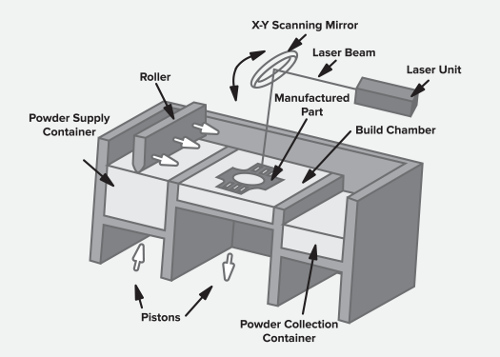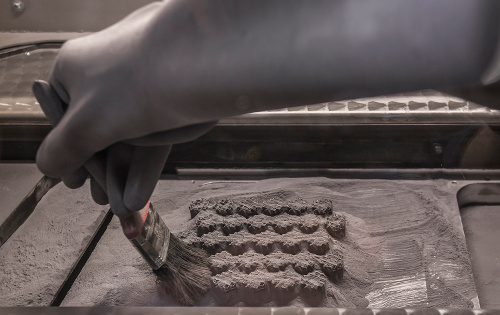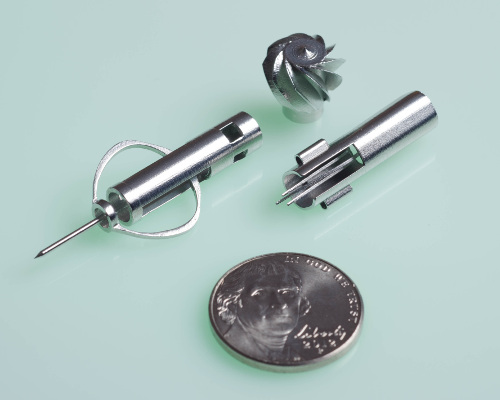 |
| May 26, 2015 | Volume 11 Issue 20 |
Designfax weekly eMagazine
Archives
Partners
Manufacturing Center
Product Spotlight
Modern Applications News
Metalworking Ideas For
Today's Job Shops
Tooling and Production
Strategies for large
metalworking plants
Engineer's Toolbox:
Why DMLS is a reliable additive alternative for complex metal parts
By Gus Breiland, Customer Service Engineering Manager, Proto Labs
When the first direct metal laser sintering (DMLS) machines hit the production floor, some in the manufacturing community assumed the end of traditional machining was near. After all, how cool is it to fill a machine with metal powder, load a CAD file, and out pops a shiny new part a few hours later? How could a shop possibly compete with a machine that creates little waste, has no cutting tools, and touts a setup as simple as the push of a button?
As it turns out, the reality of DMLS is slightly different than those early assumptions. No "Star Trek"-like replicators here, but rather a process that complements traditional machining. DMLS produces fully dense metal parts directly from CAD models, often with an accuracy and surface finish that allows a part to go directly into service. Most importantly, if you have a highly complex part that is impossible to machine, DMLS may be the answer.
Like other laser-based additive manufacturing processes, DMLS builds parts from the bottom up. It uses a ytterbium laser to melt and fuse microscopic grains of metal powder into most any shape imaginable, provided it fits in a build chamber roughly the size of a microwave oven.
How does it work?

This illustration shows the functionality of a typical DMLS build process.
Let's say that you just uploaded a 3D CAD model of your part design to protolabs.com. This could be anything from the next greatest fishing boat propeller to an air intake for an Indy car. Proto Labs' additive technicians can turn that electronic dream into a physical reality in a few relatively quick steps:
- The CAD model is digitally sliced into paper-thin layers, and any needed support structures are designed in to aid in the laser sintering process. The file is then uploaded to one of our DMLS machines.
- The powder bed is filled with one of five high-strength alloys: aluminum, stainless steel, titanium, cobalt chrome, or Inconel. A thin layer of the material selected is then distributed across the build platform.
- As the build begins, a high-powered laser goes to work, drawing the bottom layer of the batch of parts, along with any temporary support structures necessary for the build process.
- A rubber wiper scrapes another thin layer of metal powder across the parts, and the lasing process is repeated.
- Once complete, the nearly finished part is removed from the build chamber. The build supports are removed, and the parts may then be further processed per customer requirements.
That is, essentially, DMLS. As in every other additive process, part quality is very dependent on a sound build strategy. For starters, DMLS requires support structures to hold features in place as the part is being built. Without them, flat areas may curl -- a T-shape would turn into a Y, a dinner plate becomes a pie tin. For the most part, Proto Labs customers can leave support placement to the DMLS experts, but they should understand that unsupported surfaces do tend to warp during the build, and secondary post-processing will be needed to saw, grind, or machine those supports away.

Metal powder is brushed away from a bed of intricate aluminum parts.
Tolerances and surface finish
Part tolerance is another design consideration. High-resolution DMLS builds at a layer thickness of 0.0008 in. (0.02 mm) and can produce very accurate parts, with tolerances to +/- 0.003 in. (0.076 mm), part features as small as 0.006 in. (0.152 mm), and surface finishes similar to that of a sand casting. If you require a smoother finish, Proto Labs offers a number of finishing operations, including bead blasting, hand polishing, and painting.
For those concerned about the metallurgical properties of laser-sintered parts, don't be. DMLS uses laser power to actually melt individual metal particles. Each pass of the beam overlaps the previous one and re-melts the layer directly underneath, merging the metal into a homogenous mass that's 99 percent as dense as conventionally formed materials.
The ability to create intricate internal features by "drawing" them one layer at a time opens the doors to previously impossible part designs. Complex structures and multi-part assemblies can be greatly simplified using DMLS.
For example, GE Aviation reduced the part count in a fuel-injector assembly from 18 to just 1 by using DMLS, and anticipates that more than 100,000 laser-sintered parts will be produced in this manner by 2020. And with the variety of alloys available, DMLS is enjoying increased use in the aerospace, medical, and consumer industries -- everything from orthopedic implants and surgical tools to gas turbine and exhaust components are being produced today, in prototype and production quantities alike.
The message here is that those who understand how to take advantage of metal laser sintering technology have highly complex metal parts manufactured with ease while reducing overall bill of materials (BOM).

Cobalt chrome is one of five metal materials used to create small medical and automotive components.
Part of that understanding comes from knowing how DMLS works. Because parts are built in layers, so-called "stair stepping" will occur on angled surfaces -- for example, the sides of a pyramid-shaped part will be rougher than those of a cube. Proto Labs will attempt to orient the part build to minimize this effect, but it's important to point out any critical surfaces or features when submitting your part design, so these can be placed in the horizontal build plane. Overly thick sections should be avoided wherever possible, as these add to build time and increase internal material stresses. And if very close tolerance holes or features are required, the design should include extra material for subsequent reaming or secondary machining. As always, a conversation with one of Proto Labs' customer service engineers is recommended if any questions arise.
Remember that DMLS is not necessarily a faster, simpler alternative to machining. Part size is limited, since even a large-format DMLS machine maxes out at around 10 in.3 at Proto Labs. The upside to this is that the entire volume can be utilized -- if you wanted to produce a thousand microscopic surgical instruments in 316 stainless steel, DMLS can make them in a single build.
The process of melting metal one ultra-thin layer at a time also isn't terribly fast -- our instruments may take a few days to build. For many parts, CNC machining remains the most economical choice. For everything else, DMLS may offer a number of advantages, chief among them is design flexibility.
Lighten up
If you're thinking about trying DMLS, another bit of advice is in order: Parts can be laser sintered far more quickly and at substantially less cost if they're hollow.
Unless you're looking for the world's most expensive paperweight, there's no reason to melt every square inch of each powder layer when all that's required is tracing enough of the outline to ensure its structural integrity. For this reason, DMLS is a great option for product designers aiming for lightweight parts: Compared to machining, where lightweighting increases processing time and cost, DMLS is the opposite, becoming less expensive as part weight goes down.
This is an important point to aircraft and automobile manufacturers, where every ounce counts in terms of fuel efficiency. As mentioned previously, DMLS produces complex parts in lightweight material such as aluminum and titanium. In those applications where these materials are still too heavy, Proto Labs may suggest magnesium as an alternative. At 108 lb (49 kg) per cubic foot, magnesium is the lightest of structural materials and can be machined or thixomolded (a process that combines the best attributes of injection molding and die casting).
Here again, part design is a key factor in determining which process is best. Due to their complex, three-dimensional shapes, tiny surgical instruments work well with laser sintering, whereas parts containing straightforward features (mounting brackets, manifold blocks, electronics housings, and many other components) can be readily machined in lower volumes. And where higher quantities of metal parts are needed, metal injection molding (MIM) or magnesium thixomolding may be the answer. Whichever way you go, it's a brave new world of metal fabrication, one that Proto Labs is well-equipped to help you explore.
For more information on DMLS, read through Proto Labs' comprehensive white paper on 3D printing, or contact a customer service engineer at 877.479.3680 or customerservice@protolabs.com.
Published May 2015
Rate this article
View our terms of use and privacy policy
